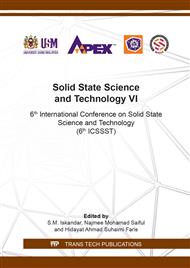[1]
F. A. Sabah, N. M. Ahmed, Z. Hassan, and N. H. Al-Hardan, Sensitivity of CuS and CuS/ITO EGFETs implemented as pH sensors,, Appl. Phys. A Mater. Sci. Process., vol. 122, no. 9, p.1–6, (2016).
DOI: 10.1007/s00339-016-0362-7
Google Scholar
[2]
R. Yossawat, P. Supanit, B. Win, K. Narathon, P. Apirak, J. Wutthinan, S. Awirut, C. Woraphan, H. Charndet, P. Amporn, and N. Jiti, High sensitive nanocrystal titanium nitride EG-FET pH sensor,, Adv. Mater. Res., vol. 802, no. September, p.232–236, (2013).
DOI: 10.4028/www.scientific.net/amr.802.232
Google Scholar
[3]
C. Tsai, J. Chou, T. Sun, and S. Hsiung, Study on the sensing characteristics and hysteresis effect of the tin oxide pH electrode,, vol. 108, p.877–882, (2005).
DOI: 10.1016/j.snb.2004.11.050
Google Scholar
[4]
S. Chang, C. Li, K. Chen, S. Chang, C. Hsu, T. Hsueh, and H. Hsueh, Investigation of ZnO-Nanowire-Based Extended-Gate Field-Effect-Transistor pH Sensors Prepared on Glass Substrate,, vol. 4, no. xx, p.1–5, (2012).
DOI: 10.1166/sam.2012.1410
Google Scholar
[5]
J. C. Fernandes, R. A. S. Nascimento, and M. Mulato, Effects of Measurements Conditions on an Extended-Gate FET used as pH sensor,, Mater. Res., vol. 19, no. ahead, p.0, (2016).
DOI: 10.1590/1980-5373-mr-2015-0248
Google Scholar
[6]
M. A. Rosdan, S. H. Herman, W. F. H. Abdullah, N. S. Kamarozaman, and M. I. Syono, Sputtered Titanium Dioxide Thin Film for Extended-Gate FET Sensor Application,, p.219–222, (2013).
DOI: 10.1109/rsm.2013.6706513
Google Scholar
[7]
R. De Castro, D. Tadeu, M. Mulato, and E. Maria, Comparative Sensibility Study of WO 3 ph Sensor Using EGFET and Ciclic Voltammetry,, Mater. Res., vol. 18, no. 1, p.15–19, (2015).
DOI: 10.1590/1516-1439.252513
Google Scholar
[8]
S. Wu, Y. Wu, and C. Lin, High performance ISFET-based pH sensor utilizing low- cost industrial-grade touch panel films as the gate structure,, p.2131–2133, (2014).
DOI: 10.1109/jsen.2015.2455057
Google Scholar
[9]
V. K. K. V. Khanna, Fabrication of ISFET microsensor by diffusion-based Al gate NMOS process and determination of its pH sensitivity from transfer characteristics.,, Indian J. Pure Appl. Phys., vol. 50, no. 3, p.199–207, (2012).
Google Scholar
[10]
F. Lin, H. Chang, and S. Hsiao, Preparation and Characterization of Nickel Oxide- Based EGFET pH Sensors,, in Ninth International Conference on Sensing Technology Preparation, 2015, p.402–405.
DOI: 10.1109/icsenst.2015.7438430
Google Scholar
[11]
J. Šauta Ogorevc, C. Parameswaran, R. P, and V. V, Comparison Of Wet And Dry Oxidation Of Silicon Dioxide Engineering Essay,, V.I.T University, 2015. [Online]. Available: www.uniassignment.com/essay-samples/engineering/comparison-of-wet-and-dry-oxidation-of-silicon-dioxide-%0Aengineering-essay.php.
Google Scholar
[12]
G. M. Ali, R. H. Dhaher, and A. A. Abdullateef, pH Sensing Characteristics of EGFET based on Pd- Doped ZnO Thin Films Synthesized by Sol-gel method,, vol. 4, no. 2, p.234–238, (2015).
DOI: 10.1109/taeece.2015.7113632
Google Scholar
[13]
Y.-L. Wu, S.-P. Chang, S.-J. Chang, W. Y. Weng, and Y.-H. Lin, A Novel pH Sensor Using Extended-Gate Field-Effect Transistors with Ga2O3 Nanowires Fabricated on A Novel pH Sensor Using Extended-Gate,, Sci. Adv. Mater., vol. 6, p.1–4, (2014).
DOI: 10.1166/sam.2015.1992
Google Scholar
[14]
Y. Chiu, C. Tseng, and C. Lee, Nanostructured EGFET pH Sensors With Surface-Passivated ZnO Thin-Film and Nanorod Array,, vol. 12, no. 5, p.930–934, (2012).
DOI: 10.1109/jsen.2011.2162317
Google Scholar
[15]
B. Huang, J. Lin, and Y. Yang, ZnO / Silicon Nanowire Hybrids Extended-Gate Field-Effect,, vol. 160, no. 6, p.78–82, (2013).
Google Scholar
[16]
N. C. S. Vieira, A. Figueiredo, A. D. Faceto, A. A. A. De Queiroz, V. Zucolotto, and F. E. G. Guimarães, Sensors and Actuators B : Chemical Dendrimers / TiO 2 nanoparticles layer-by-layer films as extended gate FET for pH detection,, Sensors Actuators B. Chem., vol. 169, p.397–400, (2012).
DOI: 10.1016/j.snb.2012.01.003
Google Scholar
[17]
Z. H. Ibupoto, K. Khun, and M. Willander, Development of a pH Sensor Using Nanoporous Nanostructures of NiO,, J. Nanosci. Nanotechnol., vol. 14, no. 9, p.6699–6703, (2014).
DOI: 10.1166/jnn.2014.9373
Google Scholar


